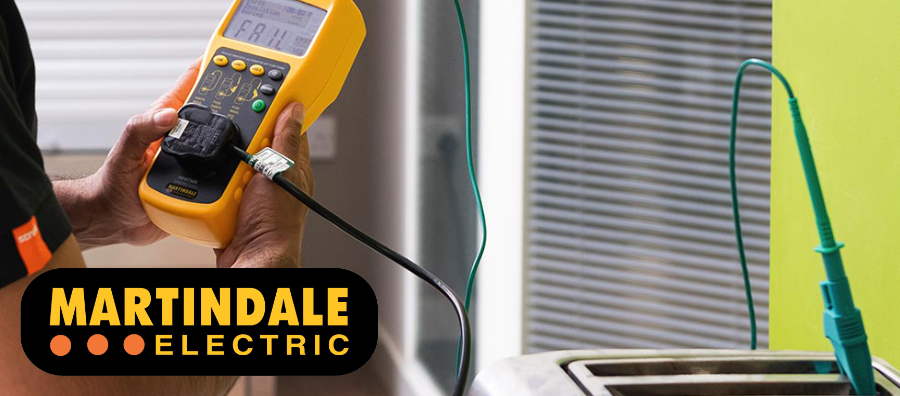
PAT testing is a crucial part of any preventative maintenance programme, especially when it comes to ensuring the safety of your employees or customers. If you're not doing it right, you could be putting them - and your business - at risk!
Paul Wilson of Martindale Electric has explored 12 of the most common PAT testing errors and unveiled the strategies to rectify them like a true pro. So fasten your toolbelts and prepare for an enlightening journey.

Visualise Success: Don't Overlook the Power of Inspection
It may seem obvious, but before diving into testing, give your appliances a thorough visual check. Inspect for any damage, scratches or dents to the casing. These clues might indicate mishandling in the past and should be recorded as it could indicate that the appliance is unsafe. Additionally, inspect the cable for wear and tear, ensuring proper connections. Safety starts with a keen eye.

The Power of Sequence: Follow the Right Order
Testing order matters! For Class 1 appliances, don't rush into the insulation test. Most PAT Testers use the earth wire as the return signal path, which is why you don’t need to use a probe for the insulation test. So first ensure the conductive earth path is solid by testing it separately; only then can you rely on the insulation test.

Switch it on: Highlighting Hidden Hazards
When conducting an insulation test, think about the situation where the live wire is broken inside the appliance and touching the outer casing. By powering the appliance, you can detect any voltage leakage through the live wire, as everything inside the appliance should be at 250V / 500V. If you haven't switched it on, the voltage can’t get through the live wire, meaning nothing will escape and you will have an incorrect pass of a dangerous appliance. Don't be left in the dark — always switch on to highlight potential dangers!

Hands-Off Policy: Shockproof Yourself
Resist the temptation to hold tools or gadgets during testing. Even if most appliances pass the insulation test, don't get into the a habit of holding drills etc. (although it may make it easier to hold the probe in contact). Keep your hands to yourself, because you never know the one day the appliance insulation fails and you get a shock. Safety first, my friends!

The Bonding Conundrum: One Earth, Multiple Paths
BEWARE of this common pitfall! Don't settle for a single-earth bond test (even though some of the earliest downloading PAT Testers had standard test sequences that only expected you to do 1 earth test). Appliances with multiple - seemingly isolated - outer parts require separate measurements for each earthed path. Give each bond its due attention. Unite them all for ultimate safety!

The Worst Case Scenario: Breaking Averages
When faced with multiple earth paths, forget about averages. It's the worst-case scenario that demands your focus. Don't settle for mediocrity—aim for excellence. Identify the weakest link and fortify it against potential hazards!

Class II FAIL Zone: Earth Bond Test Alert
Remember this crucial point: never attempt an earth bond test on a Class II appliance. These appliances have no earth connection, rendering the test futile. This is very common problem and causes a large number of calls to technical helplines. Safety is first about knowing!

Insulation Breakdowns: Unmasking Vulnerabilities
Power tools deserve special attention when it comes to insulation breakdown. Why? Bcause it could break down at the chuck, the ventilation slots, the trigger, the assembly screws, the speed control... the list goes on! The best solution is to wrap the device in kitchen foil and test it once on the foil (you can buy special conductive bags, but foil is way cheaper). Remember, safety is all about uncovering vulnerabilities!

Fuse Check: Powering Up for Protection
No separate fuse test is required! By performing an operation test, you simultaneously verify that the appliance is on and the fuse is intact. Don't miss this crucial step in guaranteeing appliance functionality. Save time and be safe, power up to protect!

Failing To Do A Function Test: Powering It Up
It's quite common for entry-level PAT Testers to lack the ability to power up appliances, so let's not forget that after testing, plug the appliance into a wall socket and ensure it works properly. Don't leave room for embarrassment — label appliances with confidence, knowing they function flawlessly!

Voltage Vigilance: Testing with Precision
Don't fall into the voltage trap! It's a common mistake to perform a 500V test on surge protection extension leads, as these actually require a lower voltage of 250V. This distinction is especially crucial when testing appliances with surge-protected circuits, such as sensitive IT equipment. Stay vigilant and test at the correct voltage level to ensure accurate results. Let precision be the guiding light in your PAT testing journey!

Pass Level Precision: Calculating for Longer Power Cables
Many appliances are connected to longer power cables than those specified by the manufacturer. In such cases, the current pass level calculation differs from appliances with shorter power cables. Consult the PAT code of practice for the appropriate calculation method. Ensure accuracy in determining the pass level based on cable length. Don't let cable length compromise safety standards!
There you have it, 12 tips to mastering the art of PAT testing. Now, go forth and test with confidence! Remember that safety is always top priority and, by avoiding these common mistakes, you'll ensure the well-being of your employees and customers. Stay charged and stay safe!
To learn more about our range of PAT Testers, check out the full lineup here: https://www.test-meter.co.uk/pat-testing-equipment/pat-testers
